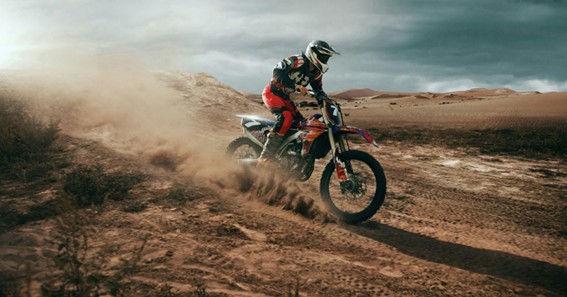Motocross is more than just a high-speed sport—it’s a full-body commitment that demands relentless training, mental sharpness, and adaptability. Riders face unpredictable terrain, harsh weather, and mechanical variables, all while pushing their physical and mental limits lap after lap. The sport’s intensity brings a high risk of injury, making preparation and recovery a critical part of every athlete’s routine.
According to Daniel Ludwick, success in motocross doesn’t come solely from talent; it grows from consistent discipline, resilience, and the ability to perform under pressure. The environment, equipment, and even the emotional toll of competition all shape a rider’s journey. From training regimens to mental fortitude and environmental challenges, every aspect contributes to a rider’s performance and longevity.
The Demands of Motocross
Motocross riders compete on dirt bikes built for speed, control, and durability, often navigating through mud, sand, gravel, or hard-packed dirt. Each track has its own layout and surface condition, which adds to the challenge and forces riders to adapt quickly.
Riders must stay physically and mentally prepared for events that test their limits across multiple laps. Whether it’s a local race or a national championship, maintaining control of the bike while reacting quickly to changing conditions is a constant requirement. Even short races demand complete focus, stamina, and the ability to recover rapidly from mistakes.
Events are rarely delayed or stopped for weather, meaning riders often face extreme heat, cold, or rain. Navigating these elements while maintaining peak performance adds to the overall demand for the sport. The unpredictability of outdoor conditions keeps riders on edge and makes preparation even more vital.
Physical Strain and Injury Risks
Motocross riders rely heavily on their entire body to control the bike, especially the core, legs, and upper body. The physical effort it takes to stay balanced while absorbing shock from jumps or rough terrain is immense. Even during practice sessions, the body is under constant tension, pushing muscles to their limits with every lap.
Injuries are common in motocross, often affecting the wrists, knees, shoulders, and lower back. The repetitive impact and strain can cause long-term wear if not properly managed. Crashes, even at moderate speeds, can result in broken bones or concussions, highlighting the importance of protective gear and technique. Recovery from even minor injuries can take weeks and affect training momentum.
To handle these, athletes dedicate hours to strength training, mobility exercises, and recovery routines. Without constant physical conditioning, it becomes difficult to maintain performance or avoid injury throughout a season.
Mental Pressure and Focus
Mental toughness is just as important as physical ability in motocross. Riders must make split-second decisions while navigating technical tracks at high speeds. A single lapse in concentration can mean the difference between staying upright or crashing out of a race. Staying mentally dialed in for the entire race duration is an acquired skill.
The mental challenge doesn’t stop at the starting gate. Dealing with nerves, pressure from competition, and the unpredictability of each race environment places a unique strain on a rider’s mindset. Position battles, unexpected bike issues, or changing track conditions demand immediate response without hesitation. Overcoming these moments builds experience and confidence.
Over time, experienced riders develop sharper instincts and greater emotional control. Mental fatigue can be harder to recognize than physical exhaustion, but it impacts reaction time and decision-making just as much. Remaining calm and focused under pressure is a skill developed through repetition and resilience. Visualization and mindfulness are often used to sharpen focus before and during events.
Training for Performance
A successful motocross athlete doesn’t just rely on raw skill; consistent training is a core part of staying competitive. Physical routines often include endurance cardio, resistance workouts, and functional movements that mimic riding demands. These sessions build stamina, balance, and control, all essential for handling the bike during intense races. Flexibility work is also incorporated to reduce injury risks.
To complement the physical side, mental preparation is woven into daily habits. Visualization techniques, breathing exercises, and pre-race routines help riders stay focused and reduce anxiety. Nutrition and sleep also play critical roles, giving the body the fuel and recovery it needs to perform under stress.
During the off-season, many riders shift their focus to refining techniques, recovering from injuries, and building foundational strength. This period is key for long-term development and helps prevent burnout once the racing calendar picks up again. It also provides an opportunity to test new equipment or riding styles in a lower-pressure atmosphere.
Equipment Challenges
Beyond weather and terrain, machinery plays a major role. A bike that isn’t properly tuned can compromise performance or lead to mechanical failure mid-race. Riders often work closely with mechanics to fine-tune suspension, gearing, and tire selection. Staying competitive means knowing not just how to ride but how the bike responds to every adjustment. Even small tweaks can drastically alter handling.
The travel schedule adds another layer of difficulty. Constant movement between events, changing time zones, and limited rest periods can wear down both body and mind. Maintaining peak performance despite these disruptions is part of what separates elite riders from the rest. Travel fatigue and unfamiliar tracks can affect confidence if not managed properly.
Building Long-Term Resilience
Setbacks are inevitable in motocross. Whether it’s a crash, a mechanical failure, or a disappointing finish, every rider faces moments that test their commitment. The ability to bounce back, analyze what went wrong, and return stronger is a defining trait of champions. Success often comes from learning through adversity rather than avoiding it altogether.
Support systems play a major role in maintaining motivation. Coaches, teammates, and even family members contribute to a rider’s mental and emotional well-being. Their encouragement, advice, and perspective help athletes push through the tough stretches of a demanding career.
Over time, riders learn to embrace challenges as opportunities and use each experience, good or bad, to fuel their progress. This steady build of resilience becomes the foundation for longevity in such a physically and mentally punishing sport.

